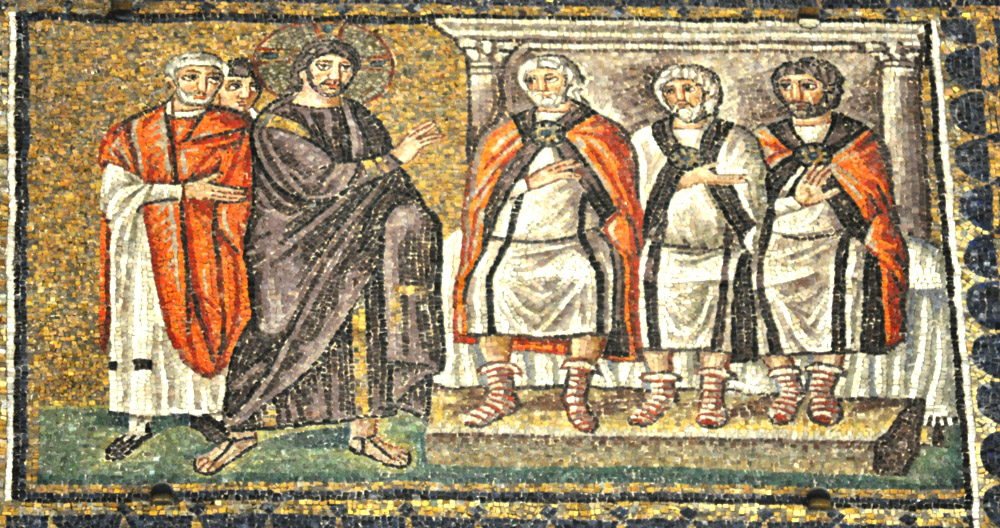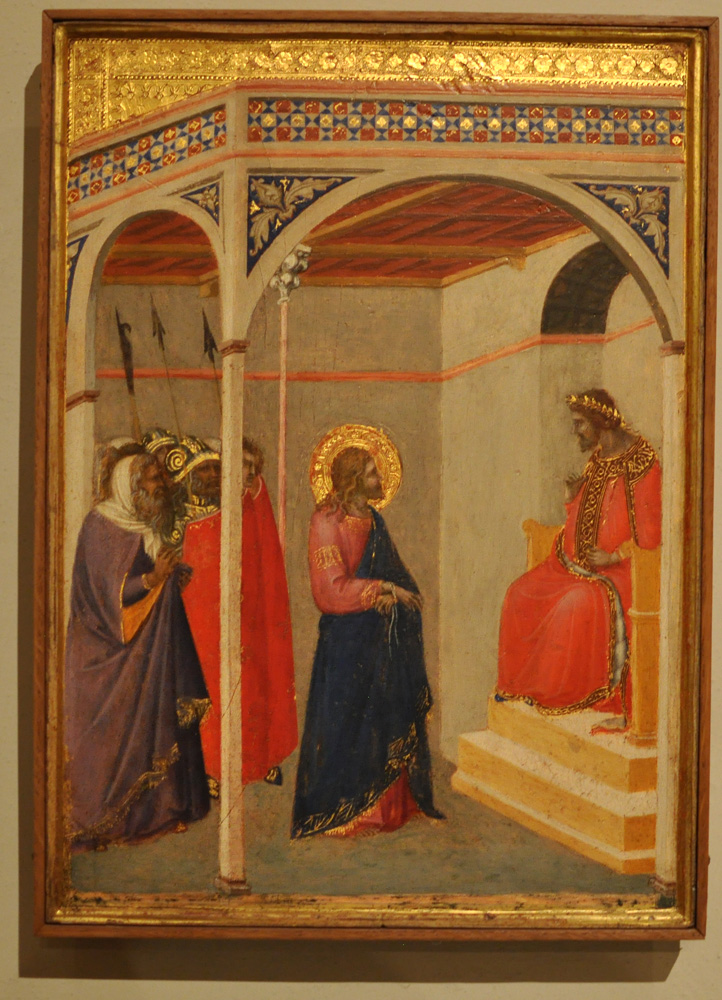THE RELUCTANCE OF PILATE AND HIS WIFE
In the morning Jesus is taken to Pontius Pilate, the Roman governor of Judea. In Matthew 27:19, his wife sends him a message advising, "Have thou nothing to do with that just man; for I have suffered many things this day in a dream [visum] because of him" (image). Artists and commentators are divided over how to see the wife's intervention. On one side, the Gospel of Nicodemus makes her a sincere intercessor who was so "sorely vexed" when Jesus died on the cross that she could not eat or drink. The Orthodox churches accept the testimony of some early writers that she was baptized into the faith, and they consider her a saint. She has a feast day on October 27 and appears sometimes in Orthodox icons with the name "Claudia Procula" (example).1But on the other side John Chrysostom suggested in the 4th century that it was the devil who gave her the dream, having figured out that Christ's passsion was a way to liberate his captives in Hell. This is how her plea was interpreted by many commentators in the West.2 In the Bedford Hours, the devil is pictured climbing onto the woman's bed to whisper in her ear, "If your husband has Jesus put to death evil will come upon him and upon you and your friends" (my translation). Many western images, however, ignore both interpretations and either present her counsel in a neutral way (example) or leave it out altogether.
Pilate is also reluctant to condemn Jesus, but the crowd insists, so Pilate washes his hands as a sign that "I am innocent of the blood of this just man" (27:24). The washing is by far the most common element in images of the trial, from paleo-Christian sarcophagi, ivories, and mosaics to medieval and baroque images to modern representations in "Stations of the Cross." In one startling exception Pilate's acquiescence in the crowd's demands is signified by his turning his back on the viewer. Pilate ordered that Jesus be scourged before being crucified. In the art and the English mystery plays he is first despoiled of his garments and tied to a pillar. These procedural details are not found in the gospels nor in the commentaries that I have consulted.3 After the scourging the soldiers put Jesus in a scarlet cloak and crown of thorns and sarcastically hailed him as King of the Jews. The mockery is pictured in this painting by Domenico Tintoretto and with a pointed irony in this sarcophagus panel, where the crowning is reimagined as a reverent crowning of a man of true dignity.
The pain and sorrow caused by these torments is represented in medieval and early modern statues intended for Holy Week processions. In some Jesus sits sadly with his hands bound and the crown of thorns on his head. This example is known at its location in Mexico as El Dios de la Peña, "God of Pain." More often its name involves the word Paciencia (example). In others he stands at the pillar in a pitiable state (example). In one case the blows have beaten him to the ground while he is still tied to the pillar. In John's gospel Pilate orders the scourging in hopes that it will be enough to satisfy the Jews, so when Jesus has been beaten bloody he shows him to the crowd (image). He tells them, "Behold the man" (19:5), which in Latin is Ecce homo, a phrase that art historians apply to portraits of Jesus as he would have appeared to the crowd – with his scarlet cloak and crown of thorns, tied wrists, and often the reed that the soldiers had given him as a mock sceptre and then used to beat his head (example). Paintings of this type served as objects of meditation. Statues, such as this one from Sicily or this one from Mexico, were used in Holy Week processions. El Greco's Disrobing of Christ displaces the scarlet robe detail to a later moment on Golgotha, shortly before the crucifixion.
Prepared in 2016 by Richard Stracke, Emeritus Professor of English, Augusta University. Revised 2016-09-02, 2016-12-12, 2021-04-14.
HOME PAGE

Jesus addresses the Sanhedrin: Church of Sant'Apollinare Nuovo, Ravenna, 6th century. (See the description page.)

Most images with Pilate have him washing his hands, but some focus on an earlier moment in the trial. This Italian example is from the 14th century. (See the description page.)
MORE IMAGES: JESUS & CAIAPHAS
- Circa 550: One of the earliest known manuscript miniatures of the trial uses visual details drawn from 6th-century judicial proceedings.
- 9th century: Fresco in Müstair, Switzerland.
- 12th-13th century: a detail in the great Easter Candle Holder in St. Paul Outside the Walls, Rome.
- 1874: a stained glass window combining the arraignment and the beating.
MORE IMAGES: JESUS & PILATE
- Early 4th century: a sarcophagus
- Late 4th century: Sarcophagus side panel with Pilate washing his hands.
- 9th century: Pilate washes his hands in this fresco in Müstair, Switzerland.
- 11th century: Midway down the left side of the "Latin Diptych" in the museum of Milan's cathedral.
- 1516-18: Juan de Balsameda's relief sculptures of the scourging and the crowning with thorns for the main retable at Oviedo Cathedral.
- 16th century: A griffin sits beside Pilate in this relief from Piazza Armerina, Sicily.
- 17th century: An Ecce Homo statue in Seville Cathedral.
- 1606: A San Paciencia statue, in which Jesus sits exhausted for a moment during the Passion.
- 1760s: Vallejo's Christ After the Flagellation models the viewer's responses to Jesus's pain.
- 20th century: Subirachs' statuary group at the Sagrada Familia in Barcelona omits the wash basin.
MORE IMAGES: THE SCOURGING
- 14th century: A relief of the scourging at Orvieto Cathedral.
- 1303-1305: Giotto's fresco of the scourging alludes to Isaiah 50:6, "I gave my body, etc."
- 1344: Detail from Guariento di Arpo's Coronation of the Virgin altarpiece.
- Late 15th century (?): A fresco in Galicia juxtaposes Christ's passion with St. Sebastian's.
- 1547-51: An altarpiece panel of the scourging at the pillar.
- 16th or 17th century: A Mexican santo of Jesus tied to the pillar where he was scourged.
- 1874: A stained glass window with the flagellation.
MORE IMAGES: ECCE HOMO
- 15th century: Messina's painting of the head only.
- 15th century: A door panel in an altarpiece in Salamanca.
- 16th century: Corregio's painting, also head only.
- 17th century / Germany: Silver plaque.
- 17th century / Spain: Sculpture in Seville Cathedral.
- 18th/19th century: The Ecce Homo in a detail from a Greek iconostasis.
NOTES
1 Gospel of Nicodemus, XI, 2. Catholic Encyclopedia, s.v. "Pontius Pilate." There is also a brief web page for St. Claudia Procula at the website of the Orthodox Church in America, retrieved 2020-06-04.
2 So John Chrysostom and Nicholas of Lyra, cited in the Glossa Ordinaria, V, 452; Rabanus Maurus, cited in Aquinas's Catena I, 941-42; and The Mirror of Salvation (Labriola, 60).
3 A stage direction in the Chester "Passion" has tunc spoliabunt eum et ad Columnam ligabunt, "then they disrobe him and tie him to the column" (Play XVI:320, Deimling and Matthews, II, 293). In the Wakefield "Scourging" another stage direction has the torturers "strip Jesus and bind him to a pillar" (line 133, Bevington, 558). In York's "Second Trial Before Pilate" the stage directions are built into the dialogue: "Late us gete of his gere [clothing]…Nowe knytte hym in this corde…" (lines 348-51, Davidson, 278.) For the commentaries, I consulted Aquinas's Catena on each of the three gospels and the Glossa Ordinaria on Matthew and Mark.